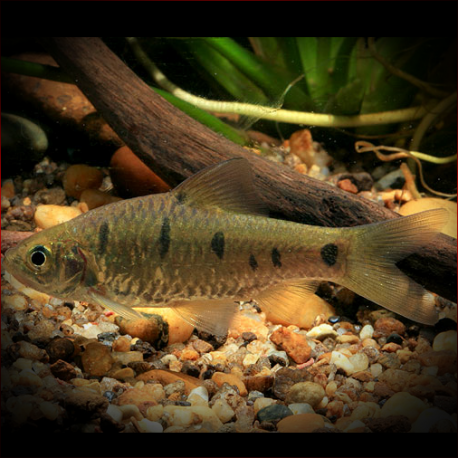More info
Datasheet
| Minimum Tank Size | 72 litres / 19.02 US gallons |
| Maximum Size | 6.5cm / 2.56inches |
| Temperature | 18°C / 64.40°F - 26°C / 78.80°F |
| Hardness | 2.02dgH / 36ppm - 15.02dgH / 268ppm |
| pH | 6.0-7.5 |
General Description
Barbodes Aurotaeniatus is an uncommon species in the aquarium trade, characterized by a single pair of maxillary barbels and a distinct color pattern consisting of small black markings on the flanks and dorsal surface. Initially placed in the genus Puntius, it was later reclassified into the genus Barbodes along with other Southeast Asian species. Juveniles of this species have specific color patterns that evolve as they grow, aiding in their identification within the Barbodes genus. With an average size of 6.5cm, these fish are known to develop better colors when kept in mixed-sex groups in well-maintained community aquariums.
Aquarium Setup
The ideal aquarium setup for B. aurotaeniatus should mimic a slowly flowing stream environment. A dark substrate and subdued lighting can enhance the fish's colors. Adding plants, bogwood, and floating vegetation provides suitable hiding spots and enrichment. Water conditions should be maintained within a temperature range of 18-26°C, a pH of 6.0-7.5, and a hardness of 36-268ppm. An adequately sized tank of at least 72 liters, with gentle filtration and water movement, is recommended to accommodate a group of 6-10 individuals.
Behaviour
Known for their peaceful nature, B. aurotaeniatus thrives in community aquariums with species that inhabit similar biotopes. Males may display more vibrant colors in the presence of conspecific rivals. Providing a mix of schooling fish for security can help create a natural-looking spectacle and promote social interactions within the tank.
Feeding and Diet
These fish are foraging omnivores, feeding on worms, insects, small invertebrates, plant material, and organic detritus in their natural habitat. In captivity, they readily accept small live and frozen foods such as bloodworms, Daphnia, and Artemia, along with quality dried flakes and granules. A varied diet rich in protein and plant matter is essential for their optimal condition and coloration.
Reproduction & Dimorphism
Reproduction in B. aurotaeniatus is possibly unrecorded, but related species follow an egg-scattering spawning behavior with no parental care. Adult males are typically smaller, slimmer, and more colorful than females, especially during the breeding season. Controlled breeding setups with dim lighting, suitable substrate for egg deposition, and proper conditioning of adult pairs can yield successful spawns.
Habitat and Distribution
Naturally found in the lower Mekong River basin, including Laos, Vietnam, Cambodia, and Thailand, *B. aurotaeniatus inhabits a variety of freshwater biotopes ranging from flowing streams to irrigation canals. They coexist with various fish species, such as Channa gachua and Rasbora paviana, in their native habitats, showcasing adaptability to diverse aquatic environments.

